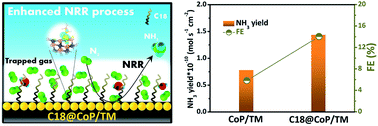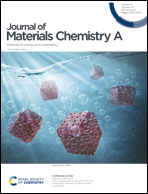Alkylthiol surface engineering: an effective strategy toward enhanced electrocatalytic N2-to-NH3 fixation by a CoP nanoarray†
Abstract
Electrosynthesis of NH3 from N2 addresses the need for renewable electricity storage and provides a promising alternative to the Haber–Bosch process. Unfortunately, it is hindered by sluggish kinetics and low faradaic efficiency (FE) due to the strong N![[triple bond, length as m-dash]](https://www.rsc.org/images/entities/char_e002.gif) N triple bond and competing proton reduction. Herein, we propose that the surface engineering of a CoP nanoarray supported on a titanium mesh using hydrophobic octadecanethiol (C18@CoP/TM) is an effective strategy to enhance the electrocatalytic activity of the CoP nanoarray supported on a titanium mesh for ambient N2-to-NH3 conversion. Such C18@CoP/TM offers an NH3 yield of 1.44 × 10−10 mol s−1 cm−2 and a FE of 14.03% in 0.1 M Na2SO4, surpassing its CoP/TM counterpart (0.783 × 10−10 mol s−1 cm−2, 5.83%). Moreover, C18@CoP/TM also shows steady NH3 yield and FE in a six-cycle test with high durability. Density functional theory calculations reveal that modifying CoP with a C18 layer leads to a regulated surface electronic structure, which further promotes the catalytic formation of NH3.
N triple bond and competing proton reduction. Herein, we propose that the surface engineering of a CoP nanoarray supported on a titanium mesh using hydrophobic octadecanethiol (C18@CoP/TM) is an effective strategy to enhance the electrocatalytic activity of the CoP nanoarray supported on a titanium mesh for ambient N2-to-NH3 conversion. Such C18@CoP/TM offers an NH3 yield of 1.44 × 10−10 mol s−1 cm−2 and a FE of 14.03% in 0.1 M Na2SO4, surpassing its CoP/TM counterpart (0.783 × 10−10 mol s−1 cm−2, 5.83%). Moreover, C18@CoP/TM also shows steady NH3 yield and FE in a six-cycle test with high durability. Density functional theory calculations reveal that modifying CoP with a C18 layer leads to a regulated surface electronic structure, which further promotes the catalytic formation of NH3.

- This article is part of the themed collections: Celebrating International Women’s Day: Women in Materials Science, 10th Anniversary: Most popular articles, Journal of Materials Chemistry A Lunar New Year collection 2022 and 2021 Journal of Materials Chemistry A most popular articles


 Please wait while we load your content...
Please wait while we load your content...